Choosing the Right Path for Facial and Body Rejuvenation
In the realm of facial and cosmetic rejuvenation, individuals face the pivotal decision between non-surgical and surgical treatments. Each approach offers unique benefits, risks, and outcomes, influencing not only aesthetic results but also recovery time, cost, and suitability. This article explores the key differences, advantages, and considerations that should guide your choice toward the treatment best aligned with your goals and lifestyle.
<!-- VIDEO:eyJsaW5rIjoiaHR0cHM6Ly93d3cueW91dHViZS5jb20vd2F0Y2g/dj1hbWJCSTBIM2ZsRSIsImltYWdlVXJsIjoiZGF0YTppbWFnZS9qcGVnO2Jhc2U2NCwvOWovNEFBUVNrWkpSZ0FCQVFBQUFRQUJBQUQvMndDRUFBa0dCd2dIQmdrSUJ3Z0tDZ2tMRFJZUERRd01EUnNVRlJBV0lCMGlJaUFkSHg4a0tEUXNKQ1l4Sng4ZkxUMHRNVFUzT2pvNkl5cy9SRDg0UXpRNU9qY0JDZ29LRFF3TkdnOFBHamNsSHlVM056YzNOemMzTnpjM056YzNOemMzTnpjM056YzNOemMzTnpjM056YzNOemMzTnpjM056YzNOemMzTnpjM056YzNOLy9BQUJFSUFGTUFsQU1CSWdBQ0VRRURFUUgveEFBYkFBQUJCUUVCQUFBQUFBQUFBQUFBQUFBQUF3UUZCZ2NDQWYvRUFFQVFBQUVEQWdRQ0JnWUdDQWNBQUFBQUFBRUNBeEVBQkFVU0lURkJVUVlURkNKaGNTTXlnWkdod1JVV1FuT1RzUWNrSlROU1l0SHdORFZqY29QaDhmL0VBQm9CQUFJREFRRUFBQUFBQUFBQUFBQUFBQUVFQUFJREJRYi94QUFtRVFBQ0FnRURCUUFCQlFBQUFBQUFBQUFBQVFJUkJBTVNJUk14TTBGUkJTSWpZWEh3LzlvQURBTUJBQUlSQXhFQVB3RGNhS0tLaEFvb3BGZHloQ2N5Z1FKaVk0ekZRZ3RSVEMxeGF6dXV6ZFU0ZjFsc3VNNWtrWjBqZVBmdFhReFMxTGJqcVZsYmJUblZyV2hKVUFyaU5QUGZZVlhjdm9hWTlvb29xd0FySk9tUW5ITDc3ejVDdGJySk9tWCtkMzMzbnlGTllhdlVGc3AxQXJtR1dKeEhGR3JRR09zVnFlUTQxcUtMWkxJUTJrYUpBQThoVk8vUi9hQjdFYnE2VUo2aEVKOHovd0NWZkZKenFUcDVHbU1xVlMyaStPcmpZazB4bUtwOVU3bnhwMWw1VGxHd3J6T2xRN3ZxamJ4OGE2SGhYSTFkVnlkTHNkYlIwZGl0OXhSQUExb1dhNDFvZzFqWnZRbXZYYWtGVHpwZFNTZDZTS2ZmVldqU0luQm9ydkthS3JSYXl5MFVVVStjMEtqc1VTcDdDN2xscVN0eEswcFA4SkpPdnMzOWxTTkZCcTFRVVZERGc3YVdXQXZLdG5uRkJseHBTU2p2TkVwSjBCaUNTa0RYblRqbzRITUg2UEx0NzFseFQ3THEwbHRLQ1M1SjBJNWd6dlZub3JLT2xUdXd1Vm5ncjJpaXRpb1ZrUFRRL3R5Kys4K1FyWHF4N3BzZjIzZmZlZklVN2crUVN6bisyaVgvQUVkTWxPRTNUeEVkYTl2ekFGV0p4d2dCS1Q2NStIR29yb2NPcjZOMnNDQ1FvL0duN2g5TVZHTmdOS3l6cC9xay93Q1RYQmhhaVBHL1ZGS0ozcU51Y1NZczJzenF0VHNrYm1vWjNwYTJna21FcEhIS1RyODY1Vm82Nml5M1VvSXFqcTZjMnJhNFhuTURYdUVSUW45SWVHRldWU2lPUkFtYXNwSURneTdPRVJUWlVlMm9hMjZSVzEyM21hV0lpYWR0M09jeUR2VlhKRmxCb2taRkZNdXY1bWlwdUp0TEhkc2h3dHJMZ1JrTWlSeGtINVUyRm9nR0JkeU5KQklrd1oxOXBwaXJwWGhDdEZLZEk4V2pYSTZVNEtOdXMvQk5idlUwMzdRbHRsOEpGdTBiU0NrdkkxQUFnUVFPVy9MU3V5aExpSUxqVVp5b0E5NEhmZjMxRi9XakJkL1NmZzE1OWFNRi9uL0JxZFNIMUUyeStFbjJac2trUHRybjdLKzhrU1NkcDhhQmJwN3MzRGF3azZCWW1abmZYeCtGUnYxcHdVUis4MC8wYVByVmczTno4R3AxTlA2VGJMNFNDck5LenJkYWxSVVJwdWZsOGZHdWxXNlM0czlwVENncUVuaG0zNCtINTFHL1duQmh0MWcvNFRRT2xHQzhBNStEVTZtbjlKdGw4SnUwU0VObktwQ2dUUGNFQWVWWkgwM2s0NWZBYmx6NUN0REhTekNFaUVxZEhrMGF6M3BPNG01eDFWd2hLK3FmZFN0QlVtTXlkQlQvQU9QMUl2VWRQMEpaMEgwMVpic0phVmE0ZmFNUU82MGtLSGp4cnhhamxNRFVrd0tXY1ZBUVFkcVNkVG9EU3VXN1kzaFJwTVJ0Yk5BVVg3b0J4MDhWYWdlQXBqaTk3WjJ5SldHOU9ZcGJGTDAydHFwY0VrRFFKM0o1Vm5GOWo5eTdmRzN3eTBGOWlSVVFYbGpNMndSd1FObFJ4VWFUcTNTT2d1RmJIR0xYS3J1VGFZWmNMVHZuUTBjdnNPMVZwVnhrZEhYMmo3WE1yUURTam5TTEduc1BUYzNlTVhBZWRlU2hpMlUyZlNKVkJLczZRQUI0Y1lxZXdsT0lPdEU0dGI5YTBGNVZ1eHFuUUVFajIvM3hMMDlxc2tkVlNkQ3VCcVVFcEtIQXB2bFY2dzVTbHRna0VhVkRXK0VOTk5wZHQwcEtkOURJSXF6WWUwTXFlR2xZTk96VzZSeXRaU1lGRlBYN2R2UDdLS3RUSzdrVmR2RGJ4eGxwNXRtVzNmVU1qWHZaZnpydHJEYndlbVEwRm9iaFJVbFlJSWpNRFBLQlVsWjI2eXhhb2J4SmFVcVJtS0VwSGNLZStCNzFHa21VWGkyMUh0aFF0MExDRzBoUGZTQUJFY05DUkhoVk5pRnR6RjdoNjljZGRDcklCeDBDQ1h3WUswRk92T1FrN1JGS09YTis1Y0Z4MnlUNmRvSC9BQklTTXNtQVR5OUlORHhBOHFSYlM2dDFDVTRuM0Z1RmdFSlRwbEs5WThvTS93QTlDV2JrTmwxbkVmU29PUkxhd0FmM2lVamZocFBoQTUxZm4vVVU0RVhIcmhWc3JycllKWklTb2p0SVNGaktrUVI5b3cyWTVTZDlLOHhONTk5cDlkM1pkV3B4TGI1VWgyT2FVbURQT0luaFhicUFrM0RYMGdweEI2dEtGQktDRnBWSW53SXpLQmlsUTI4NFFYc1NKUzRzb1VwU0VxRVpsU0JQRVpRWTRUcDRqbnNFNXNuNzVLY1BXM2JCUVZLVWtPZ0YyQVVnbmxDUVJVYXV5ZmVXbFNHUWd1S0lDRk9ETVRKQk1IV0pCSHNweXBoMjJ1N2RsTjhRa2dOSmNSc2tLQUpnOHBWNTA5WGJPQjlMZjBzSktndk1VamNyQTNIaVZHTnRKNDBLdFV3M1hZaEYyVndocExpbTRRV3V1QmtlcklFL0VlK211TE9KdURoelRjbHhwU1FTT0VtckMybDRkazZ6RVpEdVpDazVVSzZvR011aDRFSkh1clBzU3Q4VXU4U2VHQ3NYTGlndUVxUVNNdktUc1BmVGVETHA2bHBDK1ZIcVFwczBoYmg3UWxzeUlwOFVaMEFDc1V2c0Y2ZU1xRDEwNDgwZ21NN2w1T1h6Z21wTEFyRHBoOUpOMjZjZFZuS1NWNVhGTFNoUGpPaE5YeUczSzJhWXlxTlI1TlJjc2VzbE1hblNlVk1lek40YzhTaTJSSEVoTVQ1a1ZQMkFYMlJvdmZ2TWd6RTg0cnR4dEs5RkNSV0tWY2pGK21VZDNDTUpjVGxTeW9KUzRWSlNWOTFNbllDTnZDcEd3dEdnZ29EY0JTOHlqelBPckNMRzJtZXFUUGxRNHkwMGtuSkFISVVYYkl0cTdJajBXbHV3RjlXbUFyZFBDYTd0emxnRGVtWVhkWE4wWENnc1dxWkNVcTladzh6eUZPMFFqNVZrNnZnMFhia2hNUittdnBHNExUaDZrcUhWZ0dJR1VlSE9hOXIxN0dzOTVkTkJCSFVPbHN6eGdBejhhS2xCSXlLa0xKM0RrMnVTNlp6dmRhRkZVZlpsR251elZIMTZrNVZCVUF3Wmc3R2xvdW1aTldTaTNNSlBYK2pWS2xwTFpDZEVwRWFlM3ZmQ2tIdXdoRGhaVUZMRDJkc0tiTUtSL0NlVkltNVFRZjFaa1Q0SCt0TEpXZ2Q3TFphamlEVnJzcFFvMC9ob3YzbEx0eWJUSkRTTlpLZ1FSUG5CQjg2OWNkd3ZLOEcyanlRU2t5UUFrSk16cHFGRWp4cEhPbk5JUlpBYlpkZmgvZkN2Q3BCVjZ0b012S2RkS05zbER1NGZ3aFp1Q3pibEJVbUdwU1lTZTlxZGY5di9BSEdxVncvaDBFTVc2VExHWFZKRUxuY2E4dnlwcjJsdktQMVJtUnZ2L1drRkdTVEFFbllWVnpDb25tbkdwbkNydExOdUVnNVZUT2c0MURWR3F0N3BkMjZiZStVd0ZHU25MSTkxTy9qdkkvNkZNN3hvdXR4aVRUaktnc2pVYXpVTGcySjIxdmpJYVNoSVcvcEkwMm1xL2YyWFNGdGtxWVhiM1NUeFNjaXZjZjYxV09qMTdlL1hKaHU4U3Bzc2trcFVJTWtWMHN2YXRPcUZjTGRMVnV6Y25FWEhhQTdiWEFTa3huUXNTRDVjcWRPT3VKUkxTUXRmSW1CVVpiWEJVQnJUMXBjbld1VW1kcHhFRkp4UjhtWFdiWlA4Z0t6OFkvS25hNVMzQ2lTZVpwUUhTa2JoWGRpaSt4VkxrWXZLbFdsRGNIZW03emh6bEkzcGEzbFJBRlpKbTFVUjkwTFJWeTZTVVpzM2UxNDBVM3V1ajVUZTNMZ2VQcFhNOGN0QVBsWHRIa05vaktLS0tWRndydEQ3alFJYlZsazYwVVVTSHZhbmxKN3k1blE5MFZ5NDZ0Mk02cGdhYVY3UlU5QU9LS0tLQVFPMVFsdzR0T0pyU2xSQW5haWl1aCtPOHJFODN4azdhdUxMRUZSaXFQaTZsSjZhMnlrbUNXNEpyMml1dGwrSmlHRDVrYVpoaWxGcE1tcGxnbWQ2S0s0aDZIME8wa3hUZTRKNTBVVVdWajNJejdhejQwcXlvcDFTWU5GRlVSckliM0RyaGNrck5GRkZDeVVmLzlrPSIsInRpdGxlIjoiU3VyZ2ljYWwgdnMuIE5vbnN1cmdpY2FsIEZhY2lhbCBSZWp1dmVuYXRpb246IFdoYXQgUmVhbGx5IC4uLiIsInNuaXBwZXQiOiJOb3QgYWxsIGZhY2lhbCByZWp1dmVuYXRpb24gdHJlYXRtZW50cyBhcmUgY3JlYXRlZCBlcXVhbOKAlGFuZCBzb21ldGltZXMsIG5vbnN1cmdpY2FsIHNvbHV0aW9ucyBqdXN0IGFyZW4ndCBlbm91Z2guIn0= -->Key Differences Between Surgical and Non-Surgical Cosmetic Treatments
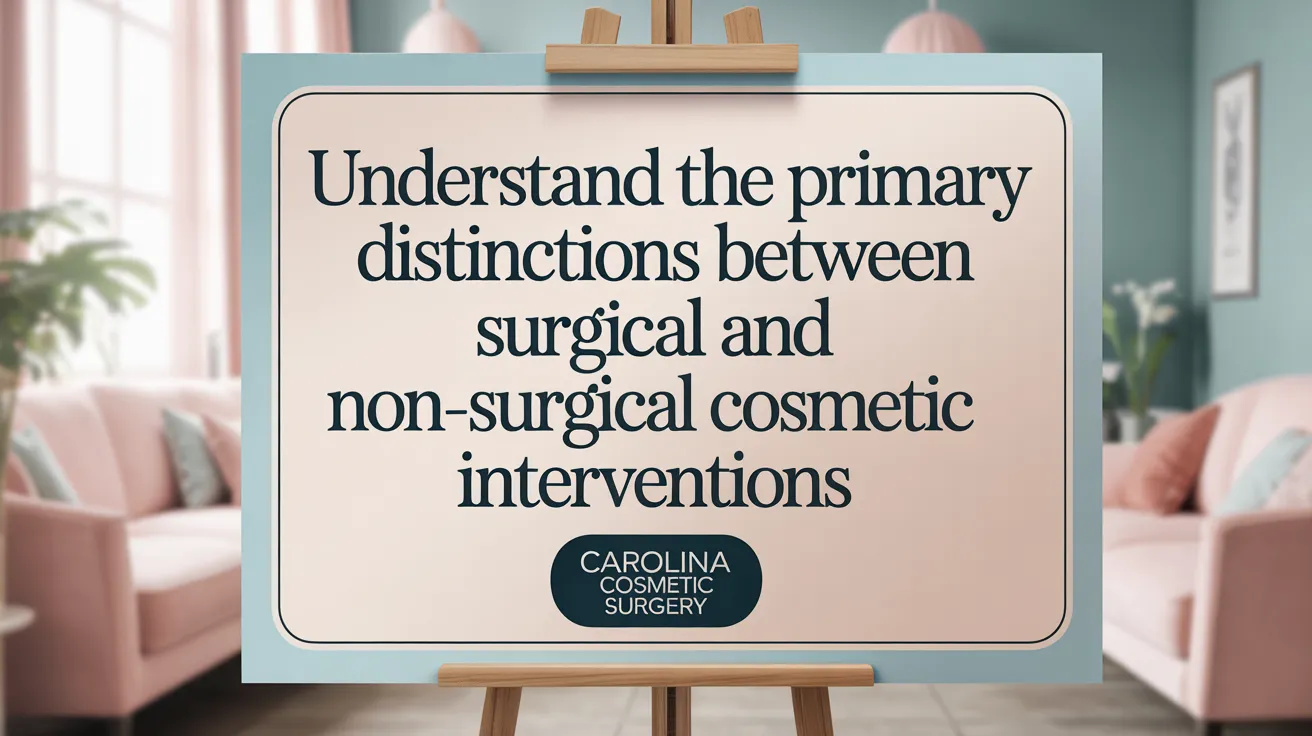
What are the main differences between non-surgical and surgical cosmetic treatments?
The primary distinction between these treatment options is how invasive they are and what kind of results they produce. Surgical treatments involve making incisions, sometimes removing or repositioning skin and tissues, and often require anesthesia. These procedures typically deliver rapid, dramatic, and permanent improvements, especially for features like the face, breasts, or body contours.
On the other hand, non-surgical options are generally less invasive or completely non-invasive. They do not involve cuts or anesthesia and are usually performed externally. These treatments, such as Botox, dermal fillers, laser skin resurfacing, or chemical peels, tend to have shorter recovery times and less risk of side effects.
Procedural elements such as incisions and anesthesia
Surgical procedures commonly involve incisions, removal or tightening of skin, and the use of anesthesia—local or general—depending on the complexity. These steps allow for significant alterations and longer-lasting results.
In contrast, non-surgical techniques avoid incisions completely. Many use needles for injections, external devices like lasers, or radiofrequency waves, with no need for anesthesia, making the procedures more comfortable and accessible.
Differences in results permanence and severity
The outcomes of surgical treatments are often more lasting and substantial, making them suitable for patients seeking significant change or correction of severe issues. Such results, once achieved, tend to be long-lasting, with some procedures offering permanent improvement.
Non-surgical methods provide more subtle enhancements. While they improve appearance and help fight aging signs, their results are often temporary, requiring ongoing maintenance or repeat treatments to sustain the effects.
Recovery durations and patient downtime
Post-surgical recovery can be lengthy—sometimes taking days or weeks for swelling, bruising, and healing to subside. Patients may need time off work and social activities.
Non-surgical treatments typically involve minimal to no downtime. Many procedures can be performed during a lunch break, with patients resuming normal activities almost immediately.
Suitability based on aesthetic concerns
Deciding which treatment is appropriate depends on individual goals and the severity of aesthetic issues. Surgical options are better suited for those seeking drastic, permanent changes or correcting significant structural concerns.
Non-surgical treatments are ideal for mild to moderate concerns, early signs of aging, or patients preferring less invasive options with quicker recovery.
| Feature | Surgical Treatments | Non-Surgical Treatments | Details |
|---|---|---|---|
| Invasiveness | High | Low | Surgical involves incisions; non-surgical involves external procedures |
| Recovery Time | Longer | Shorter | Can range from days to weeks; often minimal |
| Risks | Higher | Lower | Includes infection, scarring, anesthesia risks |
| Results | Dramatic, Permanent | Subtle, Temporary | Usually, surgical results last longer |
| Cost | Higher | Lower | Due to complexity and resource needs |
| Suitable For | Severe concerns | Mild to moderate concerns | Based on severity and goals |
Choosing between these options depends on personal preferences, desired outcomes, and professional consultations to determine the safest and most effective approach.
Benefits and Risks: What to Expect from Each Treatment Type
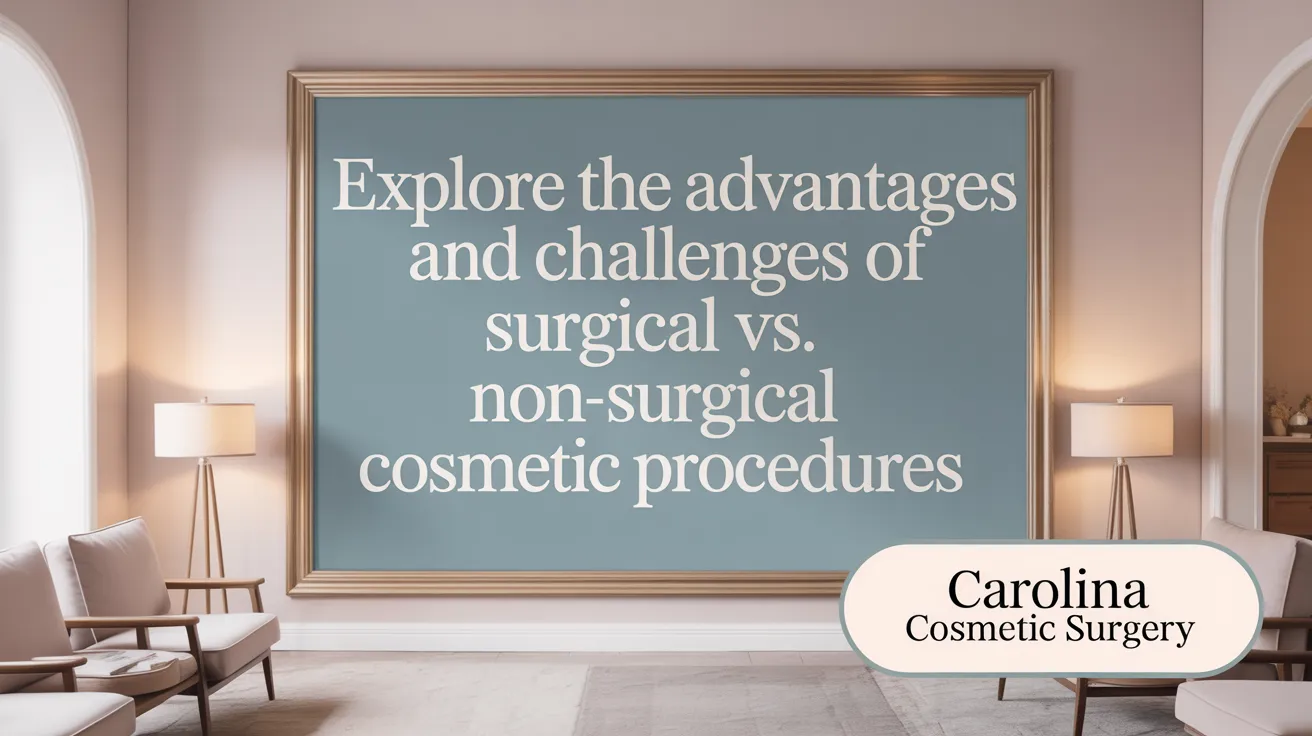
What are the benefits and risks associated with non-surgical cosmetic treatments?
Non-surgical cosmetic treatments are popular for their quick effects and minimal recovery time. They allow patients to achieve subtle yet effective improvements in facial appearance—like smoothing wrinkles, adding volume, or improving skin texture—without the need for anesthesia or incisions. These procedures often involve injectables, laser therapies, chemical peels, or skin rejuvenation techniques that can be performed in outpatient settings.
Advantages include a lower risk of complications, little to no downtime, and affordability for many. Patients can resume normal activities immediately, making them highly convenient. However, risks are present and include allergic reactions, bruising, swelling, or infection. Results may be temporary, requiring repeated sessions to maintain the desired look. Unsatisfactory outcomes or overcorrection can occur if procedures are not performed by licensed, qualified practitioners. Therefore, choosing experienced professionals and approved products is essential for safety.
What are the benefits and risks associated with surgical treatments?
Surgical cosmetic procedures, such as facelifts, liposuction, or rhinoplasty, provide dramatic and long-lasting results. They can significantly improve facial features, body contours, or correct structural issues, often boosting self-confidence and quality of life. Surgical interventions are suitable for addressing more severe concerns like deep wrinkles, sagging skin, or reconstructive needs following injuries.
These procedures generally offer permanent or long-term benefits, making them a preferred choice for individuals seeking substantial change. However, surgery involves inherent risks, including infection, scarring, pain, swelling, bleeding, nerve injury, and anesthesia complications. The recovery period is longer, often requiring days to weeks of downtime, and some risks may persist or require further procedures. Patients should discuss thoroughly with qualified surgeons, weigh benefits against potential complications, and adhere to post-operative care protocols to optimize outcomes.
Importance of consultation with qualified professionals
Whether considering non-surgical or surgical options, consulting with qualified, experienced healthcare providers is crucial. A detailed evaluation helps determine the most suitable treatment based on individual goals, health status, and the severity of concerns. Professionals can inform patients about realistic expectations, possible side effects, and the best approach for safety and effectiveness.
In some cases, a combination of treatments may be recommended to achieve optimal results. Advances in technology and techniques continue to make procedures safer and more efficient, giving patients more choices. Ultimately, personalized advice from certified specialists ensures that decisions align with safety standards and desired outcomes, leading to better satisfaction and health.
| Aspect | Non-Surgical Treatments | Surgical Treatments |
|---|---|---|
| Typical Procedures | Injectables, laser therapies, chemical peels | Facelift, liposuction, rhinoplasty |
| Recovery Time | Minimal or none, immediate return to activities | Days to months, longer downtime |
| Results Effect | Subtle to moderate, temporary | Dramatic and permanent |
| Risks | Allergic reactions, swelling, bruising, infection | Infection, scarring, nerve damage, anesthesia risks |
| Costs | Generally lower, variable | Typically higher, includes anesthesia and hospital fees |
| Best For | Subtle enhancements, early aging signs | Significant structural changes, aging, or reconstructive needs |
Making an informed choice involves understanding these differences comprehensively. Consulting qualified professionals ensures personalized, safe, and effective treatment planning.
Recovery and Outcomes: Comparing Timeframes and Results
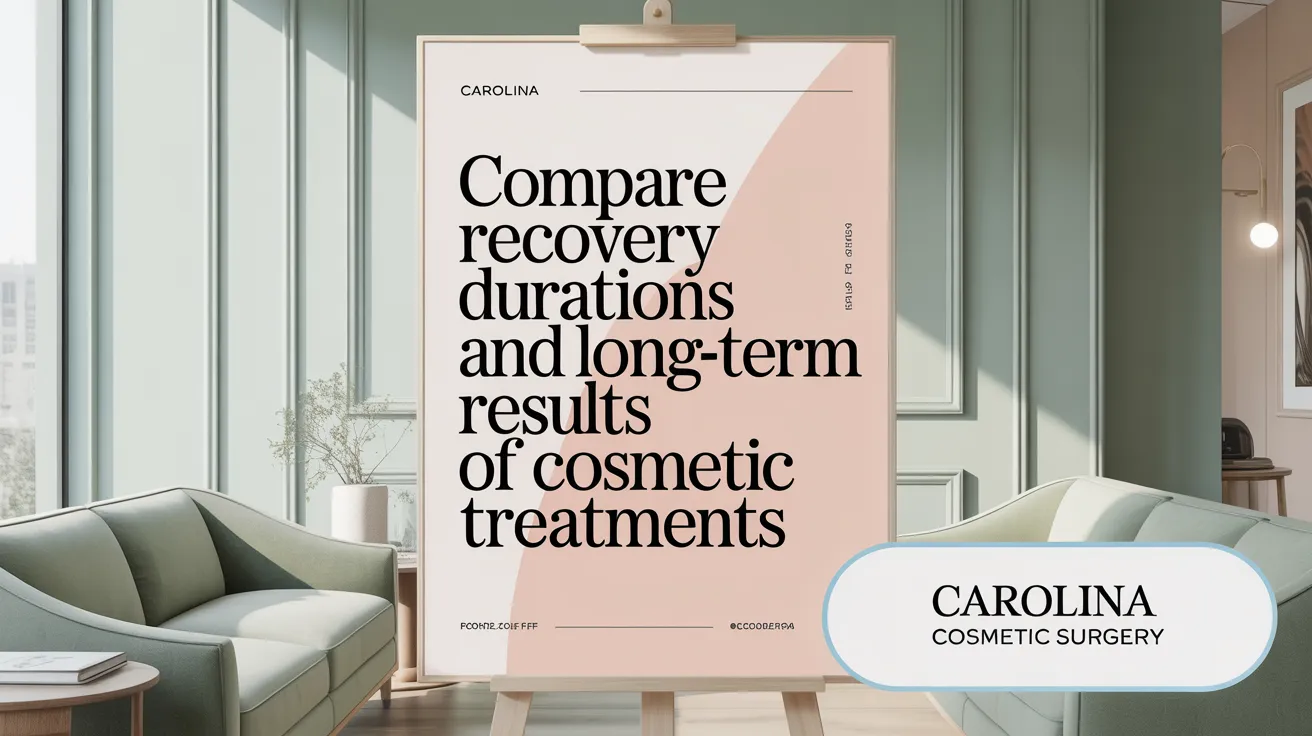 The recovery experience and longevity of results differ markedly between non-surgical and surgical cosmetic procedures, influencing patient choices based on lifestyle and goals.
The recovery experience and longevity of results differ markedly between non-surgical and surgical cosmetic procedures, influencing patient choices based on lifestyle and goals.
Typically, non-surgical treatments such as injectable fillers, Botox, chemical peels, and laser therapies involve little to no downtime. Patients can often resume their daily routines immediately or within a few days. These procedures usually deliver subtle enhancements that look natural and can last anywhere from a few months to two years, depending on the specific treatment and individual factors.
In contrast, surgical options like facelifts, rhinoplasty, or liposuction require a longer recovery period. Patients generally need several weeks to heal from swelling, bruising, and tissue recovery. These procedures can result in more significant, dramatic changes and are often permanent or last many years, providing a more lasting transformation.
The tradeoff is clear: surgical procedures deliver substantial and enduring results but involve greater risks, longer downtime, and more intensive recovery phases. Non-surgical treatments, while safer and more convenient, are best suited for subtle improvements and may require repeat sessions to maintain results.
Patients should weigh their personal lifestyle considerations, including their flexibility for recovery time and their expectations for outcomes. Those seeking minor enhancements with quick return to activities often prefer non-surgical options. Conversely, individuals targeting substantial, permanent correction may opt for surgery despite the longer recovery.
Ultimately, consulting with a qualified medical professional helps determine the most suitable approach, balancing desired results with practical lifestyle needs.
Factors Influencing the Choice Between Non-Surgical and Surgical Rejuvenation
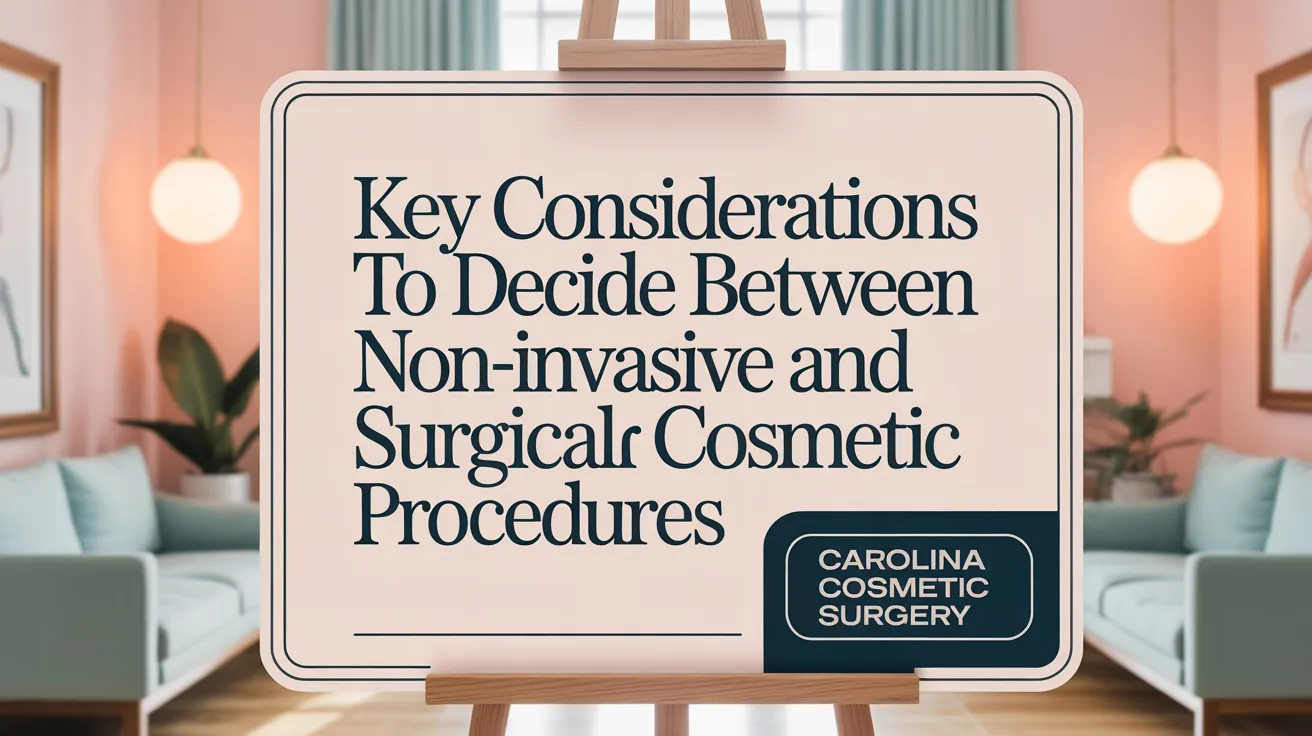
What factors should be considered when deciding between non-surgical and surgical treatments for facial or cosmetic rejuvenation?
Choosing the right approach for rejuvenation depends on several personal and medical factors. Patients often weigh their goals—whether they seek subtle, natural-looking improvements or more dramatic, permanent results.
Recovery time is a significant consideration. Surgical procedures, such as facelifts or rhinoplasties, typically require longer downtime for swelling, healing, and returning to normal activities. In contrast, non-surgical options like Botox, fillers, or laser treatments usually involve little to no recovery, allowing patients to resume daily routines quickly.
Cost is another vital factor. Surgery often comes with higher expenses due to the need for anesthesia, facility fees, and longer procedure times. Non-invasive treatments generally cost less per session but may require multiple appointments to achieve desired results.
Patients' medical history and overall health influence treatment options. For example, skin condition, age, and previous procedures can determine suitability or pose risks for certain treatments. Prior interventions, such as fillers or threads, can affect future surgical plans by complicating procedures or increasing the risk of complications.
Risk tolerance varies among individuals. Surgical options carry higher risks like scarring, infection, or anesthesia-related issues, whereas nonsurgical treatments tend to have fewer side effects like redness or swelling, which usually resolve quickly.
A comprehensive consultation with a qualified specialist is essential. Experts can evaluate individual needs, assess skin and tissue condition, and present realistic outcomes. They help patients understand the benefits and limitations of each option, preventing preconceptions from influencing the decision.
The selection should ultimately align with personal goals, lifestyle, budget, and health considerations. Tailored, professional guidance ensures a safe process and satisfactory results, whether the patient chooses non-invasive or surgical rejuvenation methods.
| Factors | Surgical Rejuvenation | Nonsurgical Rejuvenation | Additional Notes |
|---|---|---|---|
| Recovery Time | Longer, days to weeks | Minimal, often same day | Surgery involves healing of incisions and swelling |
| Cost | Higher due to complexity and facilities | Lower, per session | Multiple sessions may be needed for non-surgical options |
| Risks and Side Effects | Higher (scarring, infection, anesthesia) | Lower ( redness, swelling, bruising) | Risks depend on procedure severity and patient health |
| Result Permanence | Usually permanent | Temporary, require maintenance | Surgical results are typically long-lasting |
| Suitability | Suitable for severe aging or structural changes | Good for subtle, surface-level improvements | Depends on skin quality, medical history, and expectations |
| Treatment Goals | Dramatic, lasting changes | Subtle, natural improvements | Combination treatments may offer optimal results |
Selecting between these options involves a careful assessment of personal priorities and medical advice. Advancements in technology continue to expand both options, offering more personalized and minimally invasive solutions for patients seeking rejuvenation.
Appropriate Uses and Emerging Trends in Cosmetic Treatments
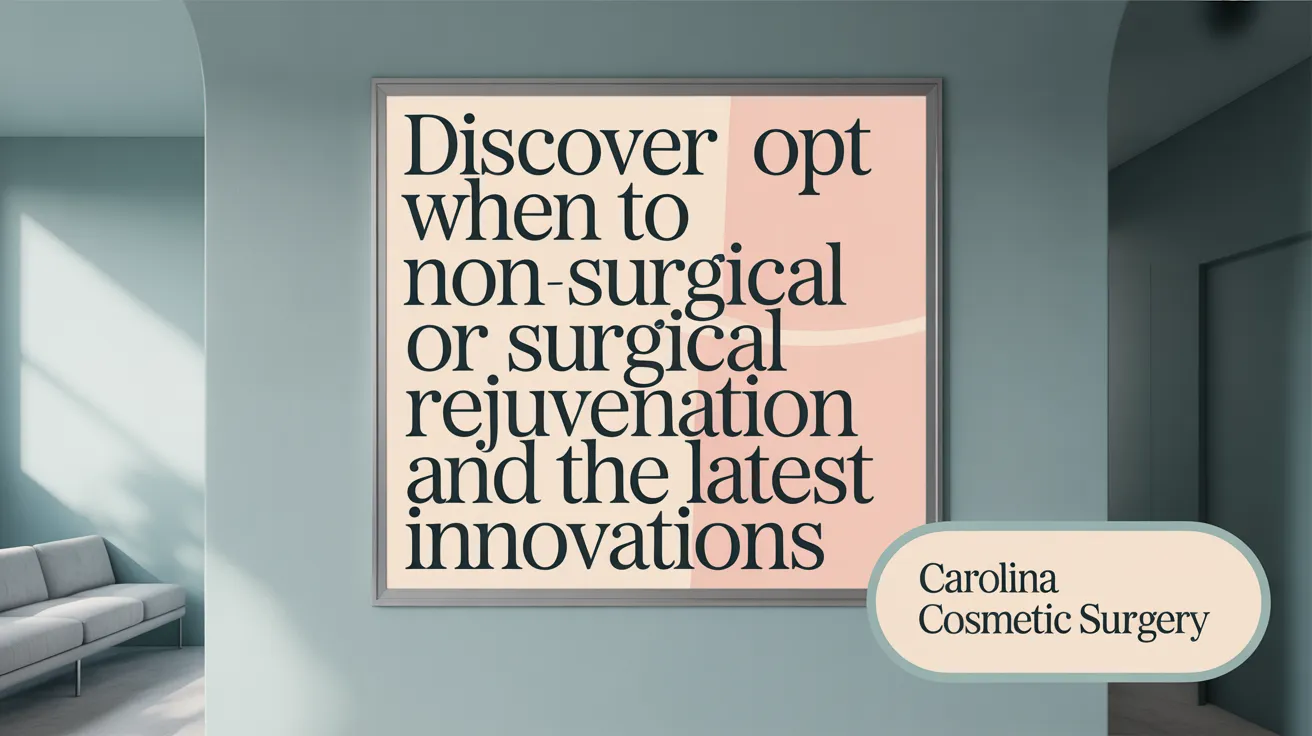
When to choose non-surgical interventions
Non-surgical cosmetic treatments are ideal for individuals seeking subtle and quick improvements with minimal or no recovery time. These procedures are often suitable for early signs of aging, such as fine lines, mild skin laxity, or minor facial volume loss. Patients who prefer temporary results or wish to postpone surgery tend to choose non-surgical options.
Common non-invasive treatments include Botox, dermal fillers, skin rejuvenation lasers, chemical peels, and microneedling. They typically involve little discomfort, no anesthesia, and do not require significant downtime, making them attractive for busy lifestyles.
Situations favoring surgical options
Surgical procedures are more appropriate when dealing with more severe or stubborn concerns that cannot be effectively addressed through non-invasive means. For example, patients with significant skin sagging, deep wrinkles, or substantial fat deposits often seek surgical solutions like facelifts, liposuction, or rhinoplasty.
These procedures offer dramatic, long-lasting results and are suitable for those prepared to accept the recovery period, potential risks, and scarring. Liposuction is particularly preferred when immediate fat removal is essential, such as for quick results before a major event, while CoolSculpting provides a non-invasive fat reduction alternative over multiple sessions.
Hybrid treatment approaches
Many modern practices combine both surgical and non-surgical treatments for optimal results. This 'hybrid' approach allows targeted interventions, such as pairing a facelift with dermal fillers or laser skin resurfacing, to address multiple aging signs simultaneously.
Such combinations can minimize invasiveness while maximizing aesthetic outcomes, providing a customized plan tailored to individual needs and goals.
Technological advances enhancing safety and results
Advances in technology, including 3D imaging and precise laser systems, help patients and doctors visualize outcomes pre-treatment for better planning. These innovations also improve safety profiles, reduce discomfort, and enhance the effectiveness of procedures.
Emerging modalities like micro-focused ultrasound and radiofrequency treatments enable superficial skin tightening and rejuvenation without invasive surgery. Such technology broadens options for patients seeking fewer risks and quicker recovery.
Popularity trends and patient preferences
There is a growing trend toward non-invasive and minimally invasive procedures, driven by the desire for subtle, natural-looking results and shorter recovery periods. Patients often see these treatments as a way to delay or complement surgical procedures.
Many individuals prefer treatments that can be performed externally without needles or cuts, such as facials, chemical peels, or laser therapies. Additionally, technological progress is making procedures safer, more effective, and accessible, further increasing their popularity.
| Treatment Type | Typical Benefits | Downtime | Suitable For | Cost Considerations |
|---|---|---|---|---|
| Non-surgical | Minimal discomfort, quick recovery, subtle results | None to a few days | Early aging signs, maintenance | Generally lower |
| Surgical | Dramatic, long-lasting, significant correction | Weeks | Severe aging, volume loss, significant deformities | Higher |
| Hybrid | Customized improvements, optimal results | Varies | Multi-faceted concerns | Moderate to high |
Choosing the right approach involves considering personal goals, health status, and consultation with healthcare providers to select the most effective and safe options for each individual.
Making Informed Choices for Your Cosmetic Journey
Deciding between non-surgical and surgical cosmetic treatments is a nuanced process that should balance desired outcomes, health considerations, lifestyle, and personal preferences. While surgery offers dramatic, permanent enhancements with longer recovery, non-surgical options provide safer, subtler improvements with minimal downtime. Advances in technology and hybrid treatment strategies continue to expand the possibilities, tailoring solutions to individual needs. Consulting with experienced, board-certified specialists is crucial to navigate options, understand risks, and develop personalized treatment plans. Ultimately, an informed choice empowers you to achieve rejuvenation that aligns with your aesthetic goals and well-being.
References
- The Pros and Cons of Surgical and Non-Surgical Procedures
- Choosing Surgery & When to Choose Non-Surgical ...
- Nonsurgical vs Surgical Procedures | Canales, Paco ...
- Surgical or Nonsurgical Facial Rejuvenation: The Patients' ...
- Surgical Vs Non-Surgical Treatment Options For Injuries
- Cosmetic Surgery vs. Non-Surgical Enhancements
- Non-Invasive vs. Non-surgical
- What Are the Pros and Cons of Non-surgical Cosmetic ...
